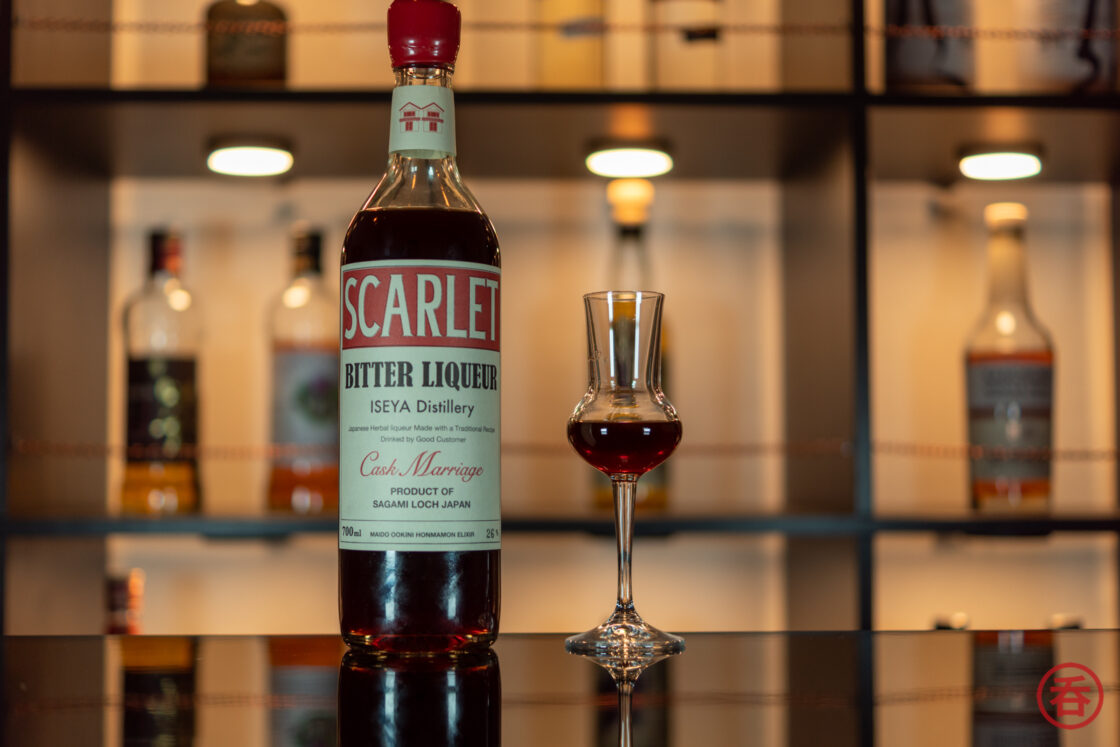Taking cues from amari like vermouth, Campari, and Fernet, the Iseya Distillery recently introduced “Scarlet Bitter Liqueur” as one of Japan’s first such liqueurs. It has quickly attracted the attention of both Japan’s cocktail lovers and whisky aficionados. Why? Let’s take a look.
Medicinal elixirs and digestifs of centuries past have continued living, or been reborn as, some of the best-selling herbal liqueurs the world has today. Chartreuse. Fernet-Branca. Vermouth. Absinthe!
What about medicinal liqueurs turned bar staple coming out of Japan? There really aren’t any. We’ve mentioned Denki Bran before when talking about Asakusa, but its predecessor “Sokusei Brandy” was released in 1882. It sold quite well! At the time, Sokusei Brandy was rumored to help ward off cholera. In any case, Sokusei Brandy was lost to history, and today’s Denki Bran is far from being a “bar staple” anywhere that’s not Kamiya Bar.
The only other potential candidate is Yomeishu, a medicinal liqueur of 14% abv that’s been around since 1602. But it remains firmly planted in the medical realm: by law it’s a Class 2 Pharmaceutical, meaning a) it sits right alongside OTC drugs like cold medicines and painkillers at drug stores, kids can buy it, and b) it has scientifically proven benefits for people’s health. I don’t see Yomeishu turning their back on over four centuries of medicine just to try and get their bottles in bars. For the record, the recommended dosage is 20ml three times daily.
Only in recent years have we seen genuinely Japanese absinthe and Japanese vermouth. Even the makers of Yomeishu have released a gin. In either Japanese or English, we can accredit Confucius for coining the phrase “good medicine tastes bitter.”
In November 2021, bartender Tatsuya Motonaga–whose career has taken him to Shibuya’s Coal Ila, Shinjuku’s BenFiddich, Taipei’s Wa-shu, and touring around 70 distilleries across Europe–released the first Scarlet out of the Iseya Distillery at Kanagawa prefecture’s Lake Sagami, inside of a repurposed 100-year old home. That’s where each batch of Scarlet is handmade and hand-bottled. There’s also a field nearby where he plans to grow his own botanicals in the future.
My bottle here, the semi-standard release dubbed “Cask Marriage,” uses 20+ blend of botanicals broken down into a few categories:
- Grass: Lemon balm, Golden Berry sprouts, sage, etc.
- Roots: Fiveleaf aralia (a species of Ginseng), Japanese pampas grass, sorrel, angelica etc.
- Wood: Cinnamon etc.
- Peels: Yuzu, Blood orange, etc.
As you can see, there are plenty of botanicals that aren’t disclosed. It’s then all matured in an ex-Japanese whisky cask for three months (and no, we don’t know which distillery).
Let’s see what all the hubbub is about.
Review: Scarlet Bitter Liqueur Cask Marriage
Nose: Mint leaves, a healthy serving of cinnamon, orange peel, charred incense sticks. Delightful.
Palate: Sweetness of cinnamon candy, like Hot Tamales. Dig deeper — quite a bit deeper, in fact — and there are hints of vanilla, dark chocolate, and tobacco leaf.
Finish: The bitterness is more noticeable on the finish than on the palate; a bit too late if you ask me. The basket of spices, however, is still going strong.
Score: B-
Cost: 4730 yen, 700ml at 26.9% abv
Scarlet definitely falls on the sweeter side of the spectrum of amari. I can see how whisky fans would reach for the bottle after a long session drinking high-abv dry stuff. I think the complexity is there, but the balance, not just yet. With more variants of Scarlet already in the works, it’s worth a revisit in the future.
Hi there! I created and run nomunication.jp. I’ve lived in Tokyo since 2008, and I am a certified Shochu Kikisake-shi/Shochu Sommelier (焼酎唎酒師), Cocktail Professor (カクテル検定1級), and I hold Whisky Kentei Levels 3 and JW (ウイスキー検定3級・JW級). I also sit on the Executive Committees for the Tokyo Whisky & Spirits Competition and Japanese Whisky Day. Click here for more details about me and this site. Kampai!

